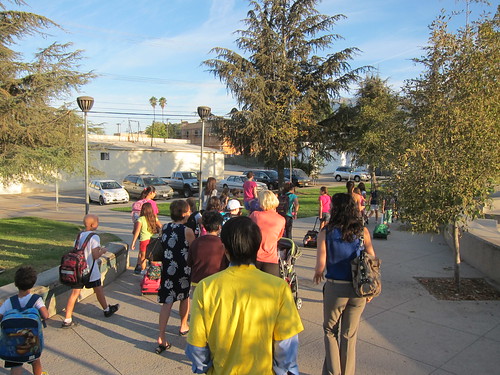 California’s climate change legislation continues to provide opportunities for bicycle and pedestrian advocates to influence regional transportation policy and finance. While SB 375 (anti-sprawl legislation) brought together a variety of stakeholders, who were often separated by artificial boundaries, AB 32, the California Global Warming Solutions Act, sets goals for the reduction of greenhouse gas (GHG) emission. The implementation of SB 375 along with Regional Transportation Plans and Sustainable Communities Strategies (RTP/SCS) developed by Metropolitan Planning Organizations (MPO) facilitates the reduction of greenhouse gas emissions in California to 1990 levels by 2020, as required by AB 32. Additionally, the AB 32 Scoping Plan identifies strategies to achieve GHG reductions, including a market-based mechanism called cap-and-trade.
California’s climate change legislation continues to provide opportunities for bicycle and pedestrian advocates to influence regional transportation policy and finance. While SB 375 (anti-sprawl legislation) brought together a variety of stakeholders, who were often separated by artificial boundaries, AB 32, the California Global Warming Solutions Act, sets goals for the reduction of greenhouse gas (GHG) emission. The implementation of SB 375 along with Regional Transportation Plans and Sustainable Communities Strategies (RTP/SCS) developed by Metropolitan Planning Organizations (MPO) facilitates the reduction of greenhouse gas emissions in California to 1990 levels by 2020, as required by AB 32. Additionally, the AB 32 Scoping Plan identifies strategies to achieve GHG reductions, including a market-based mechanism called cap-and-trade.
The cap-and-trade program, which is an incentive based system that limits or caps the amount of pollutants emitted, will be managed and administered by The Air Resource Board (ARB). ARB will distribute tradeable permits or allowances for GHG emissions to all facilities/industries required by AB 32. The money raised from the sale of these allowances must be spent on programs that reduce GHG emissions in the state. ARB is expected to craft an investment plan for cap-and-trade revenues by Spring 2013, which is a potential new revenue source for transportation planning projects at a regional level. Reuters.
The Southern California Association of Governments (SCAG) and other MPOs across the state recognize the potential for funding regional transportation planning and projects with revenues from the cap-and-trade program. A transportation funding coalition consisting of the League of California Cities, the California State Association of Counties, the California Alliance for Jobs, California Transit Association and Transportation California formed to “ensure an equitable portion” of cap-and-trade revenues will be dedicated for transportation. SCAG, The San Diego Association of Governments (SANDAG), The Metropolitan Transportation Commission (MTC) and The California Association of Governments (CALCOG) have each endorsed these principles. These endorsements include requests for dedicated revenue for transit and complete street infrastructure, investments to implement AB 32, integration of transportation and land use strategies, and incentives for local governments to make SB 375 work. For more information see: SCAG Report: Support of Cap and Trade Principles, Oct. 4, 2012.
Additionally, the cap-and-trade program provides opportunities for active transportation advocates to invest resources into “disadvantaged communities” and comment on the selection criteria of these communities. Under the cap-and-trade program, SB 535 (de León) requires 25 percent of cap-and-trade revenues to benefit disadvantaged communities and a minimum of 10 percent to be dedicated to projects located within these communities. These communities will be identified by the California Environmental Protection Agency (CalEPA) based on geographic, socioeconomic, public health and environmental hazard criteria. During the November 1st SCAG Regional Council meeting, members and staff were interested in finding ways to comment and forward principles from the statewide transportation principles into project criteria and community selection. For more information see: SCAG Report: SB 535 (de León) California Global Warming Solutions Act of 2006; Greenhouse Gas Reduction (GHGR) Fund.
What does this mean for active transportation advocates and stakeholders? There is the potential for new opportunities for bicycle and pedestrian projects and planning as well as an opportunity to significantly impact underserved communities around the state. As an example, through effective influence exerted by active transportation advocates the definition of “disadvantaged communities” under SB 535 could include neighborhoods with high numbers of bicycle and pedestrian collisions, deteriorating sidewalks and where there is a high percentage of children walking and biking to school. The insights made by our director Deb Hubsmith regarding MAP-21 are also true for cap-and-trade implementation; it is of utmost importance for Safe Route to Schools and bicycle and pedestrian supporters to be at the table during the initiation and development of new funding tools for the region. It is crucial that stakeholders and advocates continue to assert their influence and support for these concepts at the MPO level in order to revive and refocus leaders on SB 375 implementation.
Read more about the San Diego Association of Governments (SANDAG) and Southern California Association of Governments (SCAG) RTP/SCS public participation process, reflections and regional bicycle and pedestrian planning.
Region
Topics


